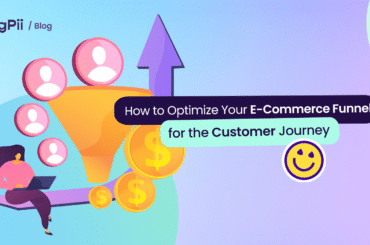For any e-commerce website, the ultimate goal is to increase sales.
This is why you have to make sure that your web pages are optimized for conversions in a way that makes the shopping experience smooth.
When running a CRO program on an e-commerce website, there are some pages that you should give more attention to than others.
Funnel pages such as category pages, product pages, cart pages, and checkout pages are far more important than others. You can’t afford to ignore any of those pages.
In today’s article, we will focus on how you can use session replays on category pages. The idea here is to understand how session replays work, how they fit in the CRO process, and how you can use them to uncover conversion bottlenecks on category pages.
Let’s get started…
- What is a Session Replay?
- Where Do Session Replays Fit In CRO?
- Benefits of Using Session Replays in Optimizing Category Pages
- Shortcomings of Session Replay
- Examples of Session Replays Used on Category Pages
- Tips for Successful Session Replay Analysis for Category Pages
- What Makes a Good Session Replay Tool?
- Wrapping Things Up
What is a Session Replay?
A session replay is a recording that shows how your website visitors interact and engage with your site.
Sometimes, it is referred to as session recording or visitor recording.
Through session replays, you can know the pages that users visited, elements they clicked on, and how long they stayed on your site just by watching session replays.
Session replays capture different visitor activities, including clicks, scrolls, taps, etc.
Now that you know how session replay works, I’m sure you can tell how valuable they are in the process of conversion optimization.
Where Do Session Replays Fit In CRO?
So, where does a session replay fit in the CRO process?
It’s an open secret that session replay is a conversion research technique. When looking at Invesp’s SHIP CRO process; session replays lie under the data analysis, which lies under the Scrutinize step in the image below:
Scrutinize has 6 research techniques under it:
- JTBD (Jobs to be done)
- Expert review
- User research
- Data analysis
- Competitive analysis
- Usability testing
Session replays are in the data analysis stage. They enable you to see and learn from the behaviors of your users.
They help solve issues on your website, like finding areas that make users frustrated or misleading elements that can cause them to bounce off.
Also, they can identify other problems, such as which fields take the longest to be filled or make users drop off.
They can show you too if a certain CTA isn’t enticing enough for users to click on.
Benefits of Using Session Replays in Optimizing Category Pages
So, why should you use session replays when optimizing your category pages?
How will they help?
I asked Isabela Cvetko, one of Invesp’s CRO specialists, about the benefits of using session replays on category pages, and she mentioned the following:
Session replays help you figure out what went wrong with your AB test. They answer questions regarding your data, like why do you see negative results? Why are visitors not converting? What might be the element on your category page that might be the reason for the high abandonment rate?
Also, session replays help you decide whether your category page is interactive enough or not. They capture users’ interactions with your page in general and some specific elements that you need to be noticed on the page. They help you know whether these elements are doing what they are intended to do or not.
Moreover, session replays help you figure out how much time visitors spend on your category page, how many clicks per user, and how many page views per user. These metrics help you understand how your page is performing.
Furthermore, they help in revealing user behavior patterns like:
- Aimless scrollings:
Aimless scrollings refer to when users scroll up and down, jumping from one page to the other, going back and forth.
This means that they were not paying attention to the content they are looking at.
- Low session duration on a certain page:
This is when users leave the site suddenly without seeing some of the product features below the fold.
- Hesitations:
This means that your users are indecisive on whether to click the continue button, indicating that they do not trust the seller.
Shortcomings of Session Replay
Most marketers, or anyone dealing with a session replay tool, are having trouble analyzing the recordings.
Even if session replay is a vital tool in the CRO process, analyzing the data after recording is challenging and requires effort and time.
Even Khalid has been feeling the same. He even spoke about his biggest challenge with session replays, which is:
- Session replays tell you the “what,” not the “why.”
He said:
When I look at session replays, I try to really understand what the visitors are trying to do on a page. It can be very frustrating at first, but you will eventually develop muscle memory as you watch more and more recordings.
He also adds:
When you develop muscle memory, you will start looking for certain behaviors. You will know how to correlate what you see along with insights.
Another thing to think about when looking at session replays is:
- Confirmation bias
Confirmation bias is when you have preconceived notions about your users’ behaviors, why they behave this way and are biased. So you try to explain data based on your notions with no considerations for the other “what ifs?”.
In this regard, Khalid says:
You have to be very careful because you can mold the data in a certain way and segment it to prove your point. Your job is to come to the data with a question, not an assumption.
Accordingly, when you reach your data with a question, visitors will start to signal the problem. Then, you have to explore further; You look for other methods (heatmaps, analytics, etc.) to validate your insights.
Another way of countering confirmation bias when watching session replays is to have a team of three to four people analyzing the same sessions from a different room. You will then come together and compare your findings.
Examples of Session Replays Used on Category Pages
To understand how session replays work, here are some screenshots:
In the category page for this e-commerce website, which sells all sorts of bags, we found a bug; session replays showed out that there is an element placed in the wrong place.
Here is another example with the Bounce Around Effect:
- At first, the visitor started with the first stage of the funnel, “the category page.”
- Then he moved to the typical second stage, “the product page.”
- However, he bounced back to the same category page from before, which isn’t the next step with the funnel.
Tips for Successful Session Replay Analysis for Category Pages
Session replays can be a bit challenging for marketers.
What to look for?
Why are the visitors doing the following actions?
How many session replays should I watch before doing an analysis?
And so many more…
That’s why I asked my boss Khalid to give me some tips on how to analyze session replays; here is what he said:
- Look for high interactivity
First, don’t just look at one or two session replays; look at as many as possible, but the important thing is to look at ones with high interactivity.
Pages with high interactivity help you get the correct data.
- Look for patterns
Start by making an assumption about what do you think this visitor is doing on this session.
For example, if a visitor went from the category page to the product page, then instead of clicking on the “add to cart” button, they went back to the category page then to another product page.
Right here, you might assume that they are doing so because they can’t find the information they are looking for. This may or may not be true.
Then you start watching the second session recording, where you will determine your hypothesis based on the user behavior, whether they repeat the same steps or not.
When you reach session replay number 20 or 30, you will start seeing very clear patterns of how the visitor is interacting with the website.
These patterns can be:
- Bounce Around Effect
The typical funnel flow starts with the category page, followed by the product page, add to cart, the cart, and finally checkout.
The Bounce Around Effect is when your visitor bounces around instead of going down the funnel. For example, a visitor goes from the category page to the product page and then to the category page again.
- Elements visitors interact with
These are the elements within your category page or any other landing page that your visitors interact with the most.
It can be clicking on a specific CTA, hovering around a certain product description, using the search bar, etc.
- How often do visitors scroll down the page?
How far are your visitors scrolling down your category page?
Do they reach just above the fold area? Or do they go further?
For example, if they aren’t going down further, this means that there might be a problem there, which you need to check.
- Patterns between converters vs. non-converter
This means that you monitor activities done by converters and apply them for non-converters.
For example, if you find out that converters are constantly clicking on images. Then you should launch an AB test to push non-converters to click on images because that is a pattern converters do.
What Makes a Good Session Replay Tool?
- Site speed/browser speed and performance should not be affected
When choosing a tool, pick one that can go hand in hand with your site/browser speed.
You would want a tool to handle your website perfectly and run smoothly without interruptions.
- Data retention
Some companies might consider data retention an important factor when choosing their session replay tool.
Why?
Because having data retention in a tool will help you store lots of data. And depending on this tool, you will be able to retain days, weeks, or maybe even months of sessions.
However, what do you think?
Does it really matter? Should it be a factor considered when looking for a session replay tool?
- Number of session replays you can capture
This factor differs based on your traffic. Before choosing a tool, check your website numbers to determine what tool and package you need.
- Search, segmenting, and filtering sessions
Look for a tool that will let you segment easily and filter sessions according to date range, duration, number of page views, user type, device, and so on.
- Price
Of course, price is a crucial factor. You need to check your budget and prioritize your spending to know which category of tools you will be looking at.
Wrapping Things Up
Now you have a complete guide on what to do when using session replays on category pages.
By now, you know the role of session replays in the CRO program, the benefits of using them, the shortcomings, examples, and what to look for in a session replay tool.



